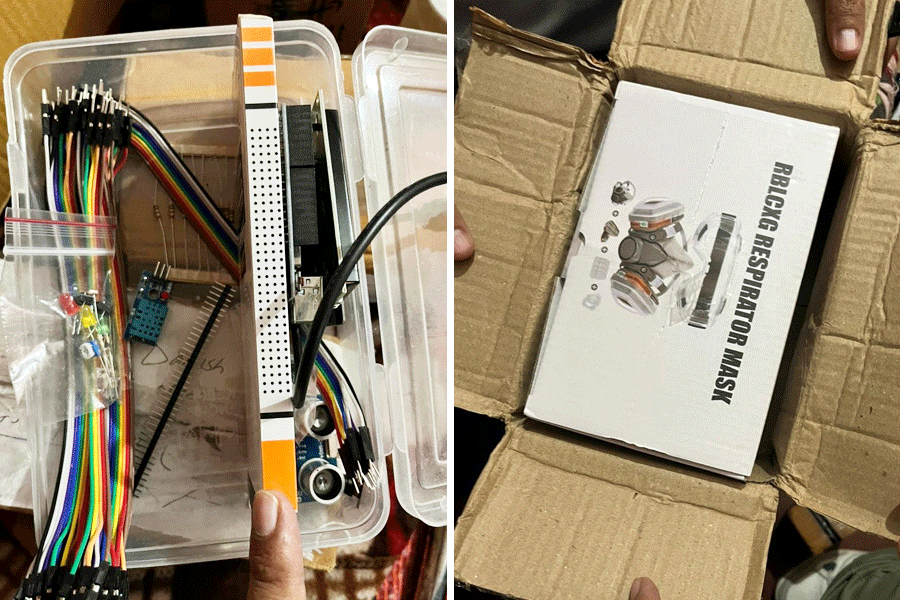 |
One would usually associate the spectacle of flying dishes, hats, knives and sticks of fire with that of a carnival or a circus. But with juggling fast gaining popularity, such intricate acts of balancing are entering the household arena.
Priyo Dasgupta, a small-scale businessman based in east Calcutta, enjoys playing with fire. “It keeps me focussed,” he says. He has mastered the art all by himself but prefers to keep his hobby a private affair. In addition to fire sticks, he can play with balls, daggers and ropes.
Juggling as an art started in ancient China. The Egyptians and Romans were enthusiastic and it was very popular with the nomadic tribes. The principal aim has always been to entertain, irrespective of the time and place. In India, juggling has been portrayed in films like Satyajit Ray’s Joy Baba Felunath and Sandip Ray’s Phatikchand.
There are several levels of juggling that are based on the number of objects one can handle simultaneously. Amateurs generally start with two balls and gradually progress to prove their dexterity with more objects.
There are 10 juggling levels that are officially recognised. The first stage involves playing with three balls and the last stage with nine. “I am still in the first stage,” says Dasgupta. Practitioners of the art revel in the game no matter what the level, since the unalloyed pleasure of controlling several objects all at once is not bound by any rule book.
Perhaps the most famous juggler from Bengal is Abhay Mitra or Lathida, the man whose dagger-throwing exploits in Joy Baba Felunath amazed many. Having conducted more than 50 tours across the country and abroad, he is pleased that juggling is gaining popularity in Bengal. His two juggling academies have elicited a good response from youngsters. Almost 200 children have enrolled for his juggling course at the Adyapith Natmandir and their enthusiasm is proving infectious. “My aim is to produce 100 jugglers within the next five years and the keenness of children in this sport warms my heart,” he says.
The biggest advantage of taking up juggling as a hobby is that it helps you develop high levels of concentration coupled with excellent hand-eye coordination. It can be a demanding pastime compared to other hobbies. But the rewards are great for those who persist.
Says Sandipan Chakraborty, a resident amateur juggler of east Calcutta, “I have attended several juggling classes in Adyapith and it was a revelation that juggling could be so entertaining. I started with balls but now I can juggle swords and carpets,” he says.
He is also capable of riding on balls and balancing them on the tips of his fingers. Chakraborty has conducted some informal shows and loves to display his skill among friends and associates.
There is much more to juggling than just playing with balls. Balancing swords is an act of finesse that requires a great deal of practice. The swords are held at the tip of a small stick and in turn balance plates and cups. Abhijit Mitra, a teacher at the Adyapith Juggling Academy, stresses the necessity of steering the course for beginners pursuing such intricate acts. Mitra says that the time taken to master juggling varies from three to six months. “Once mastered, juggling can be a source of income,” he maintains.
Women seem to be taking as much of an interest as men in this sport. Mousumi Majumdar, a resident of Kasba, has not only learnt juggling but has passed on her acuity to her daughter, Adrita, who at the age of six has done shows on television.
“During my trips abroad I noticed juggling is accorded a lot of attention and I am glad that India too is gradually giving jugglers the attention they deserve. My daughter has received encouragement from her teachers,” she explains.
Aesthetically pleasing sights like ribbon dancing make juggling seem more than just a hobby and elevate it to the level of a sublime art. It can also be dovetailed to magic and gymnastics. For the skillfully adept, the rewards are aplenty. Prafulla Barik, a resident of Howrah, performs juggling as well as magic. “Just watching the objects forming patterns in the air can be mesmerising,” he says.










